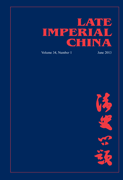By Janet Gilbert, Journals Direct Response and Renewals Senior Coordinator
It’s the best part of my week—every week—when I get to talk with journal editors or association administrators and hear the passion in their voices as they speak about their publications or societies and the global effects their scholarship is having across a particular discipline.
Shortly after I joined the journals marketing department here at the JHU Press in 2010, I started thinking about translating that academic verve into video—not simply because this format can showcase a journal’s inherent product personality, but because this is one of the key ways intelligent people seek, experience, and share knowledge today. (I suppose I also paid attention during my Hopkins orientation, and totally bought into President Gilman’s “disseminating-knowledge-beyond-the-walls-of-academia” thinking that is at the core of our mission here. Yes, this is the level of nerd I am—I took notes during orientation.)
On some level, my desire to bring video interviews onto the Press website was largely based on my family room research. Anytime my three children are at home together, they invariably end up around the computer, swapping videos. They are not all comedic clips—not that there’s anything wrong with that! They are thoughtful, insightful pieces like Meryl Streep’s commencement speech at Barnard, and Neil DeGrasse Tyson’s greatest sermon.
Oh, all right—I’ll admit it. Monty Python’s Ministry of Silly Walks might also come up.
My point is, we all augment our learning today by using the vast amount of content available to us on the web. And it turns out that my family room research is substantiated by experts in the field—video attracts visual learners, builds search results, and taps into the awesome power of YouTube. So, whether it’s an interview, a clip from a newscast, a scene captured on the street by a person with a smartphone, or an excerpt from a documentary, we now expect to be able to see as well as listen to our subjects of interest in some form or another.
We want to be able to get to know our subjects in other ways, in other words.
This is how I rather organically arrived at the title for the Journals videos In Other Words. We deal with a significantly smarter-than-average population of editors, readers, and contributors at the JHU Press. And when you hear them speak—in their own words about the work that they do—there is an unmistakable, well, academic verve that significantly adds to the content.
See for yourself, with our first video on the American Quarterly special issue on sound. Please enjoy and stay tuned for more installments on the videos section of the Journals new multimedia page.

